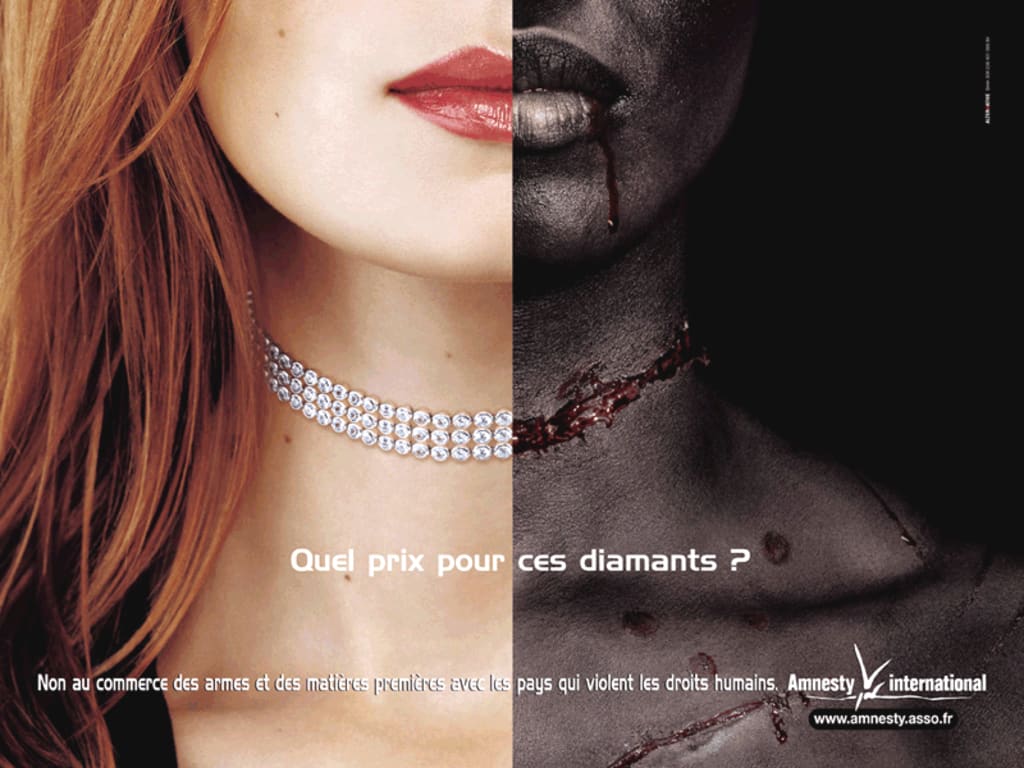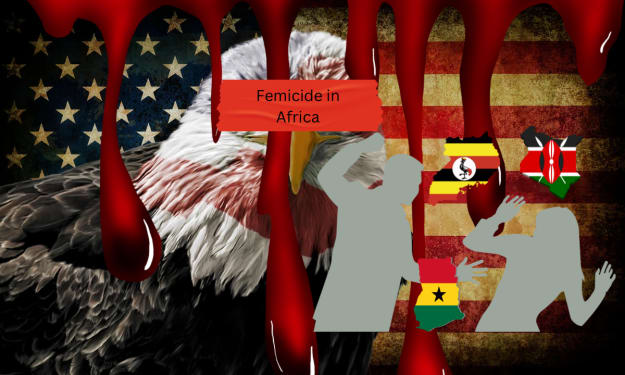"Quel prix pour ces diamants?" Twenty-plus Years After the Advertisement That Changed Multiple Perspectives
This advertisement was very controversial at the time of its release. Readers' discretion is advised.

"Quel prix pour ces diamants?"
Twenty-plus Years After the Advertisement that Changed Multiple Perspectives
Diamonds have symbolized everything for 200 years, from love to wealth. Although they are very common worldwide, they are an expensive natural resource. The question is, “How much would an individual pay for a necklace, earrings, or a ring made with diamonds?”
Unfortunately, that piece of jewelry may include a price that is non-refundable: the lives of millions of innocent people affected by war and violent political uprisings. So-called “blood diamonds” have been used to fund several armed wars in Africa and the Middle East; the civil wars in Sierra Leone, Liberia, and Rwanda are just some of those armed conflicts. The underground diamond-hustling market in Africa is equally as bloody as the current drug-hustling conflict in Latin America. Diamond cartels are willing to annihilate or kidnap anyone who stands in their way, even civilians, in a bloody and disturbing fashion; nobody is spared from the brutal bloodshed.
Would you buy a bracelet or a pair of earrings knowing that millions of innocent people have lost their lives? Human life, the rise of dictators, and mass terrorism is a price that can never be refunded for store credit. Although diamonds can never symbolize death in a million years, bloodshed is an unfortunate piece of the process that takes diamonds from mine to store.
Blood diamonds are an issue that has been nearly unheard of for the past twenty years. Although Leonardo DiCaprio starred in the blockbuster smash hit movie Blood Diamond, which was set during the 1990s civil-war in Sierra Leone, people still failed to see the bloody reality behind the diamond trade. Despite its realistic portrayal of the war that began as a rebellion to overthrow military dictator Joseph Said Momoh, the Academy Award-nominated film fell short in its portrayal of how the issue affects the entire world.
That is why Amnesty International France intervened to raise awareness. By introducing its “Quel prix pour ces diamants?” advertising campaign in the early 1990s, people began to show concern. On the left half of the billboard, the advertisement shows a woman from a Western country wearing a diamond choker necklace. On the right, the billboard shows a woman from Sierra Leone covered in bruises and scars from her lip to her chest with her throat slashed, scars, and blood dripping from her lip. The right half of the advertisement is printed in black and white, with only the blood dripping from the woman’s lip printed in red; the left half of the advertisement is printed in full color. With “Quel prix pour ces diamants?”, which translates to “What price for those diamonds?” from French to English printed across the faces of both women in white text, the portrayal of the eleven-year-long bloodshed in the former Italian colony is all too realistic. With its realistic portrayal of the effects of armed conflict on civilians, the thought of millions of innocent people dying for a material item is what provoked Westerners to care about the conflict. As a result, several top-brands halted business practices and production in Sierra Leone in the name of showing solidarity with the victims of this crisis.
One of the most commonly-asked questions regarding the issue of blood diamonds asked is, “How does the issue of blood diamonds affect me?” Another fairly common question is, “I don’t live in Sierra Leone or any other third-world countries, so why should I care?” Blood diamonds are an issue for several different reasons. Through control of natural resources, several dictators have risen to power in past years. Due to ongoing wars on the African continent and in other regions of conflict, it seems as if a new dictator has risen to power immediately after one has been overthrown. Throughout history, several dictators have risen to power through taking control of natural resources. Former Liberian dictator Charles Taylor took control of the diamond and timber industries in order to rise and cling to power throughout the 1990s, a similar tactic used by warlord Joseph Saidu Momoh.
Several major companies do business in nations that were historically under the rule of a dictator or are currently under a dictatorship. Without knowing it, a consumer could have aided a dictator’s rise to power by spending anywhere between $500 and $4,000 on a ring or necklace meant for a loved one. Aiding a dictator’s rise to power is the last thing on a consumer’s mind when purchasing a piece of jewelry. Conflict diamonds are often imported from nations known for harboring terrorist groups, such as Rwanda and Somalia. Several terror organizations, such as the Lord’s Resistance Army (LRA) and al-Shabaab, are rooted in nations where terrorists are harbored; many of these groups are aligned with the Islamic State in Iraq and Syria (ISIS) and al-Qaeda. That $4,000 profit could be used to unintentionally fund several radicalistic terror organizations. Such capital could easily fund several radical groups. Buying diamonds that were most likely processed and mined with slave labor is wrong, unethical, and corrupt.
Two common questions are, “What can I do to ensure that my piece of diamond jewelry does not come from a war zone?” and “What major companies do not buy diamonds from war zones?” The answer to both questions is very simple: support companies that don’t mine in nations of conflict, e.g. Yemen or Central African Republic. Lewis Charles Tiffany, founder of Tiffany and Company, never purchased or set up mines in nations that were colonies of nations such as Italy, the United Kingdom, the Netherlands, or Belgium; this protocol still holds true today. With various companies learning from the mistake of owning mines in conflict regions, business practice in warring nations is slowly becoming a thing of the past; keep in mind that no company or jewelry retainer is perfect.
Even companies with the strictest protocols for foreign mines are prone to error. De Beers was subject to scandal in 2015 after a discovery that several diamonds were smuggled from South Africa to the Central African Republic for processing, versus local processing. This practice was covered up with bribes given to employees for years. Outrage from the international community led to prosecution of the parties involved; the amount of outrage was than what resulted from the infamous Olympus scandal of 2011. Although organized crime activity going on as early as the 1970s had never happened in this scandal, the outrage that followed led to boycotts and severed ties from affiliate companies. Consumers should support companies that mine in their home nation whenever you can; Russian jewelry company, Alrosa, has only owned mines in Russia since its founding in 1953, a practice which holds true nearly sixty-four years after the company’s founding.
In conclusion, the purchase of blood diamonds not only contributes to the mass slaughter of millions of innocent people, but to the rise of dictators and terrorism. Knowing that death at the hands of several dictators was a part of the process that gets diamonds from mine to store can and will make an unsuspecting purchaser think twice about purchasing that necklace, ring, bracelet, or pair of earrings for their loved one. There are multiple ways to show that individuals do not support diamonds being purchased from war zones. The lives of millions of innocent people in warring nations at the hands of several dictators will always be a non-refundable price. Death and slave labor in horrific conditions should never be a part of the price of a material item.
Works Cited
Amnesty International France, “Quel Prix Pour Ces Diamants?” advertisement campaign, 1991
Amnesty International, ‘Conflict Diamonds, publication, 2003
BBC, ‘Sierra Leone Profile’, 2017
Better Diamond Initiative, ‘Another Diamond Scandal Rocks De Beers’, BDI contributor, 2015
CNN, ‘How Diamonds Fuel Africa’s Conflicts’, Paul Armstrong, 2012
Forbes, ‘How Dictators Come to Power in A Democracy’, Jim Powell, 2013
Global Issues, ‘Control of Resources; Supporting Dictators, Rise of Terrorism’, Anup Shah, 2002
Global Initiative, ‘Central African Republic Diamonds: Not Ready For Sale’, Nanar Idriss, 2014
IOL, ‘Diamond Scandal Hits De Beers’, Baldwin Ndaba, 2015
MarketWatch, ‘How To Find Conflict-Free Diamonds’, Jeanette Pavini, 2014
NPR, ‘Sierra Leone’s Diamonds Still A Source Of Contention’, Tamasin Ford, 2012
PBS Frontline, ‘Rwanda Timeline’ 1999
USN, ‘What You Need To Know About Terrorism In East Africa’, Paul D. Shinkman, 2013
Vice News, ‘The Diamond Trade Is Fueling Conflict In The Central African Republic’, Samuel Oakford, 2015





Comments
There are no comments for this story
Be the first to respond and start the conversation.